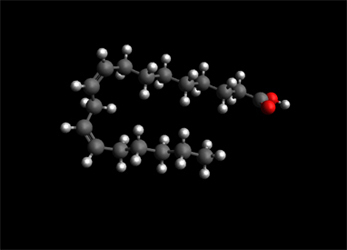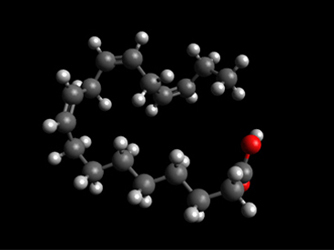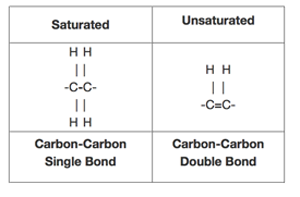What are essential fatty acids and why are they necessary?


What is the difference between saturated and unsaturated fatty acid?
All fats, including saturated fatty acids, have important roles in the body. In saturated fatty acids the carbon atoms are essentially saturated with hydrogen atoms. All the bonds are single bonds. In unsaturated fatty acids there are less hydrogen atoms attached the the carbon atoms, instead we see double bonds in some locations between carbon atoms. The number of double bonds and positions are critical to function. See types of fatty acids for more information.

Above: The structure of saturated and unsaturated chemical bonds looks like the diagram below.
What are essential fatty acids and why are they so important?
The most important fatty acids however are those that the body cannot make. These fats must come from the food we eat. These fats are called the essential fatty acids (EFAs) and are not saturated but are unsaturated fats. The essential fatty acids are based on linoleic acid (omega-6 group) and -linolenic acid (omega-3 group). There are two types of linolenic acid, alpha-linolenic and gamma linolenic. Gamma-linolenic acid is not an essential fatty acid since your body contains an enzyme called delta-6-desaturase which ca convert the essential omega-6 fatty acid linoleic acid into gamma-linolenic acid in your body.
Omega-6 fatty acids (also referred to as ω-6 fatty acids or n-6 fatty acids) are a family of polyunsaturated fatty acids that have in common a final carbon-carbon double bond in the n-6 position, that is, the sixth bond, counting from the methyl end.Linoleic acid-C₁₈H₃₂O₂- CH 3 (CH2)4CH=CHCH2CH=CH(CH2)7COOH ,

Linoleic acid (18:2, n−6), the shortest-chained omega-6 fatty acid. Food sources high in linoleic acid and other omega 6-fatty acids include: seeds and nuts, safflower, sunflower, corn, soybean and sesame oil. You can also acquire omega-6 fatty acids from meat, poultry, seafood and eggs.
Table 3. Food sources of linoleic acid (PFA 18:2), listed in descending order by percentages of their contribution to intake, based on data from theNational Health and Nutrition Examination Survey 2005-2006
| Rank | Food item | Contribution to intake (%) | Cumulative contribution (%) |
|---|---|---|---|
| 1 | Chicken and chicken mixed dishes | 9.3 | 9.3 |
| 2 | Grain-based desserts | 7.5 | 16.8 |
| 3 | Salad dressing | 7.4 | 24.2 |
| 4 | Potato/corn/other chips | 6.9 | 31.2 |
| 5 | Nuts/seeds and nut/seed mixed dishes | 6.5 | 37.7 |
| 6 | Pizza | 5.3 | 43.0 |
| 7 | Yeast breads | 4.5 | 47.5 |
| 8 | Fried white potatoes | 3.5 | 51.0 |
| 9 | Pasta and pasta dishes | 3.5 | 54.6 |
| 10 | Mexican mixed dishes | 3.3 | 57.9 |
| 11 | Mayonnaise | 3.1 | 61.0 |
| 12 | Quickbreads | 3.0 | 64.0 |
| 13 | Eggs and egg mixed dishes | 2.8 | 66.8 |
| 14 | Popcorn | 2.6 | 69.4 |
| 15 | Sausage, franks, bacon, and ribs | 2.1 | 71.5 |
Specific foods contributing at least 1% of octadecadienoic acid in descending order: other fish and fish mixed dishes, margarine, burgers, crackers, rice and rice mixed dishes, beef and beef mixed dishes, other white potatoes, beans, candy.
Omega−3 fatty acids, also called ω−3 fatty acids or n−3 fatty acids, are polyunsaturated fatty acids (PUFAs) characterized by the presence of a double bond three atoms away from the terminal methyl group in their chemical structure.Alpha- Linolenic acid-C₁₈H₃₀O₂- CH3-(CH2)-CH=CH--CH2-Ch=CH-CH2-CH=CH-(CH2)7COOH

Food sources high in linolenic acid and other omega 3 fatty acids include: camelina seeds, flaxseeds, chia seeds, walnuts, pecans, wild berries, navy beans, avocados, whole wheat bread, oatmeal, pumpkin seeds, soy beans, tofu, onions, tuna and chicken.
Table 6. Food sources of alpha-linolenic acid (PFA 18:3), listed in descending order by percentages of their contribution to intake, based on data from the National Health and Nutrition Examination Survey 2005-2006
| Rank | Food item | Contribution to intake (%) | Cumulative contribution (%) |
|---|---|---|---|
| 1 | Salad dressing | 10.5 | 10.5 |
| 2 | Chicken and chicken mixed dishes | 6.4 | 17.0 |
| 3 | Grain-based desserts | 6.1 | 23.1 |
| 4 | Pizza | 5.8 | 28.9 |
| 5 | Yeast breads | 5.0 | 33.9 |
| 6 | Mayonnaise | 4.0 | 37.9 |
| 7 | Pasta and pasta dishes | 3.5 | 41.4 |
| 8 | Quickbreads | 3.4 | 44.9 |
| 9 | Fried white potatoes | 2.8 | 47.7 |
| 10 | Mexican mixed dishes | 2.7 | 50.4 |
| 11 | Nuts/seeds and nut/seed mixed dishes | 2.7 | 53.1 |
| 12 | Burgers | 2.6 | 55.7 |
| 13 | Margarine | 2.6 | 58.3 |
| 14 | Regular cheese | 2.6 | 60.8 |
| 15 | Dairy desserts | 2.2 | 63.1 |
| 16 | Whole milk | 2.2 | 65.3 |
| 17 | Eggs and egg mixed dishes | 2.2 | 67.4 |
| 18 | Other fish and fish mixed dishes | 2.0 | 69.4 |
Specific foods contributing at least 1% of octadecatrienoic in descending order: sausage, franks, bacon, and ribs, other white potatoes, beef and beef mixed dishes, beans, potato/corn/other chips, coleslaw, rice and rice mixed dishes, tuna and tuna mixed dishes, popcorn, vegetable mixtures.
Deficiency of essential fatty acids
We need both groups of essential fatty acids to survive. Essential acid deficiency is common in the general population, due to a disproportionate intake of omega-6 fatty acids over omega-3 fatty acids in the diet. "...Various physical signs are associated with deficiencies in these essential fatty acids. These include excessive thirst, frequent urination, rough, dry or scaly skin, dry, dull or ‘lifeless’ hair, dandruff, and soft or brittle nails. Raised bumps on the skin are particularly characteristic. (This is called ‘follicular keratosis’ as it results from a build-up of hard, dry skin around the hair follicles)..." source: Physical Signs of Fatty Acid Deficiency. In addition while the long-chain omega-3 fatty acids, eicosapentaenoic acid (EPA) and docosahexaenoic acid (DHA), can be synthesized from alpha-linoleic, due to low conversion efficiency, it is recommended to consume foods rich in EPA and DHA. (see: What are the different types of omega 3 fatty acid.
Linoleic and linolenic acid in breast milk and infant formulas
"...Breast Milk and Infant Formula Breast milk and infant formulas contain a generous proportion of both linolenic and linoleic acid. These are among the lipids that provide the main source of energy in the infant’s diet. Breast milk contains 55 percent fat compared to infant formula which contains 49 percent fat. Five percent of the calories in human milk and 10 percent in most infant formulas are derived from linoleic or omega-6 fatty acid, and smaller amounts from linolenic or omega-3 fatty acid..." source Food Sources of Linolenic Acid.
Fats in Cooking and Health
- What are the differrent types of fatty acids?
- What are Trans Fats?
- What is the difference between LDL and HDL?
- What are the different types of omega 3 fatty acid?
- What are omega-6 fatty acids?
- The importance of the ratio of omega-6/omega-3 essential fatty acids
- What is the difference between saturated and unsaturated fats?
- What causes oils to go rancid?
- What are essential fatty acids?
- Duck Fat as an alternative to butter
- How to render duck fat
- Did butter get a bad rap?
Types of Fatty Acids
Saturated